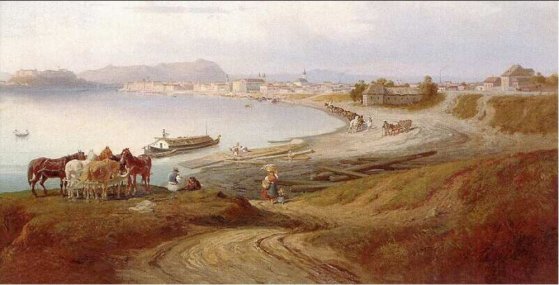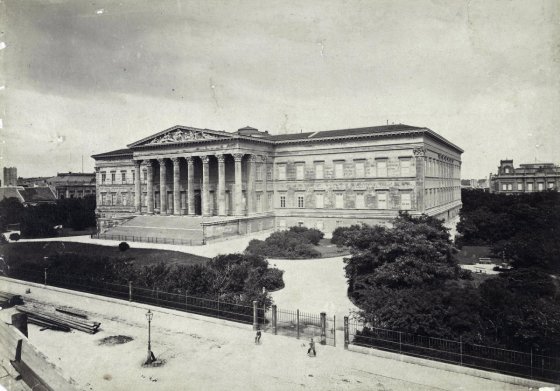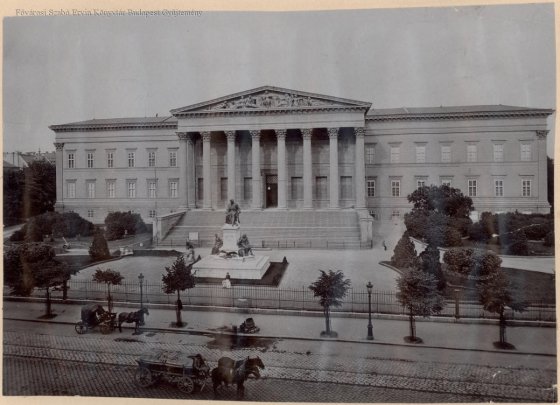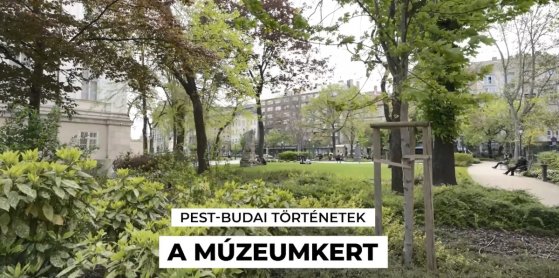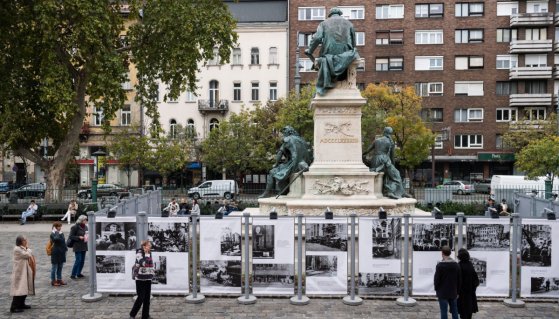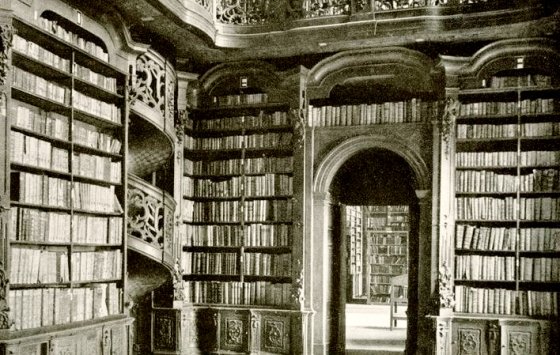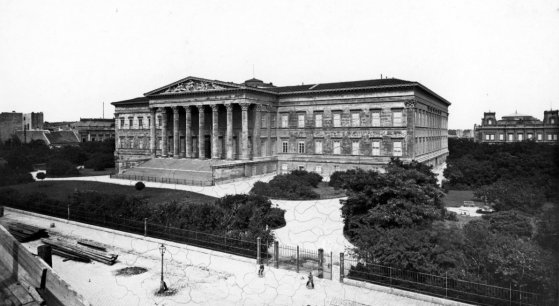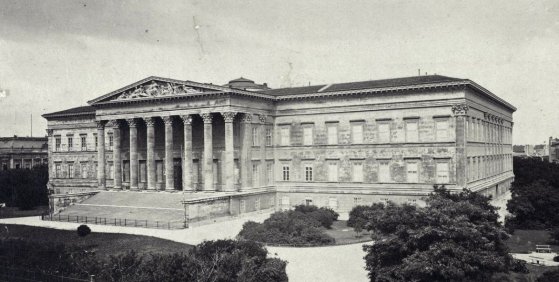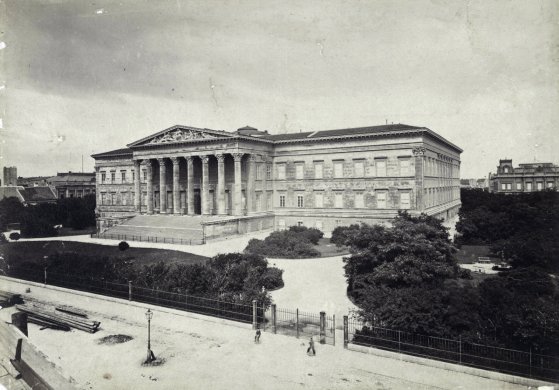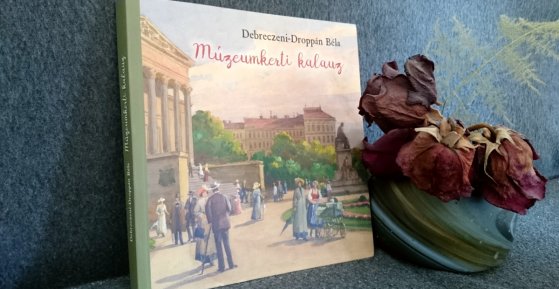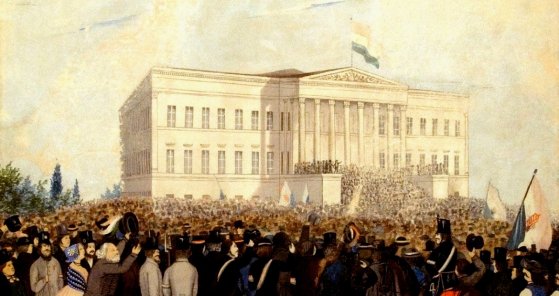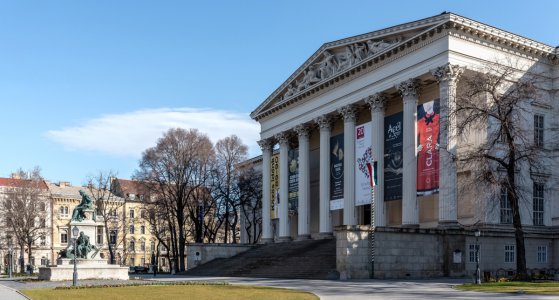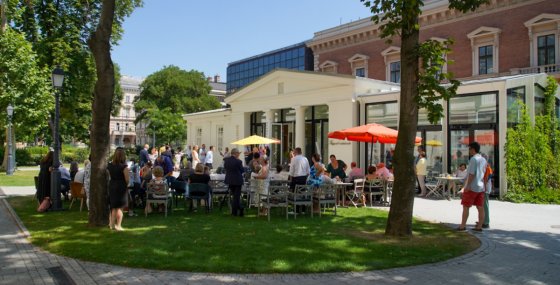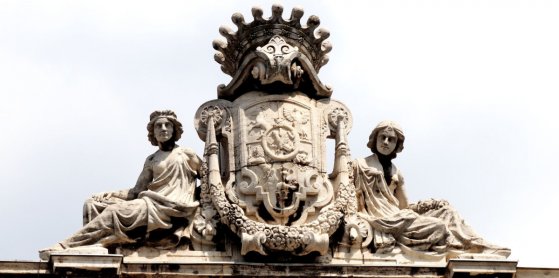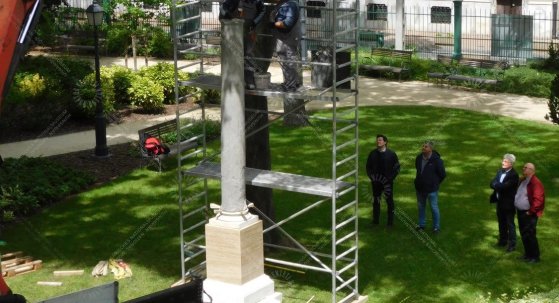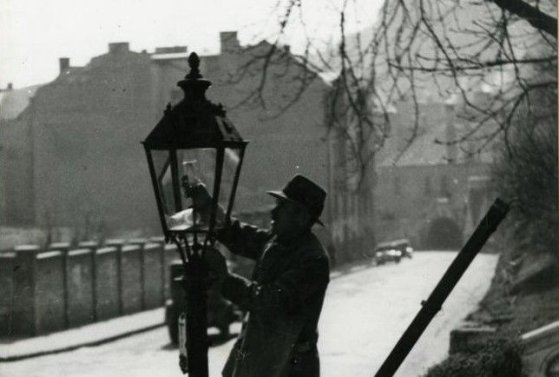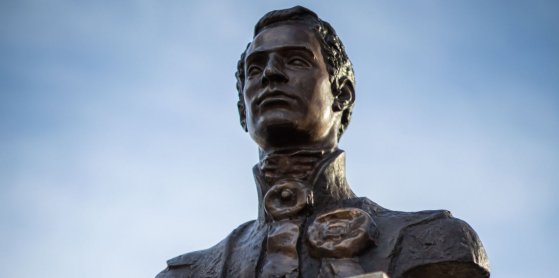 The „intertwined history” of the bridges and the city of Budapest
Which ideas and events have shaped the fate of bridges of Budapest and the cityscape? Alongside many other interesting facts, this question is also answered this newly published book by the Budapest City Archives, which introduces the history of bridges in Budapest.
The „intertwined history” of the bridges and the city of Budapest
Which ideas and events have shaped the fate of bridges of Budapest and the cityscape? Alongside many other interesting facts, this question is also answered this newly published book by the Budapest City Archives, which introduces the history of bridges in Budapest.
Hungarian National Museum
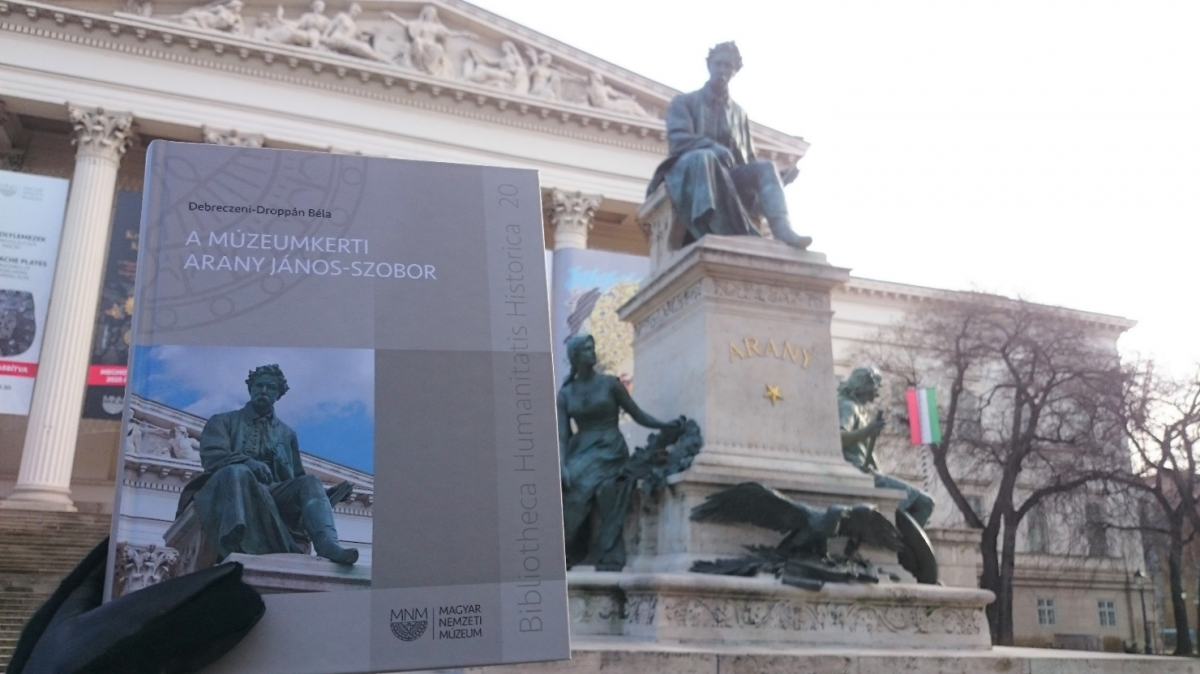 The meeting of a unique sculptor and the cult of Arany - Description of a period with the help of a 130-year-old famous monument in Pest
The meeting of a unique sculptor and the cult of Arany - Description of a period with the help of a 130-year-old famous monument in Pest
January 31, 2023 at 9:00 AM
130 years ago the first public statue of János Arany was inaugurated in front of the main entrance of the Hungarian National Museum. In a new book that has just been published, not only is the entire history of the monument and the adventurous life of its creator, Alajos Stróbl, revealed to the readers, but they can also see how the people of the 19th century thought and debated, what they considered beautiful and right, what they were different from or just similar to people now. The book, which is also rich in images, is both a colourful introduction and an exciting description of a period.
Who painted Pest and Buda several times: Antal Ligeti was born 200 years ago
January 30, 2023 at 4:00 PM
Antal Ligeti, born 200 years ago, was one of the outstanding figures of Hungarian painting. He lived in extraordinary places, first in the Fót castle of Count Károlyi István, later in Budapest's most famous classicist palace: the National Museum building. He owed his first home to the support of the lord, who recognised the talent of the young painter and provided him with housing and board as a patron. He earned his home in the building of the National Museum as the keeper of the picture gallery, lived there for more than twenty years, and was taken to the cemetery from there.
It became the most important work of classicist architecture: the new National Museum opened its doors to the public 175 years ago
January 24, 2023 at 5:00 PM
When the country's most important classicist building, the National Museum designed by Mihály Pollack, was completed in 1847, it took time to properly house the artefacts and books collected over the decades and to create the exhibition spaces. The classicist palace opened to the public 175 years ago, on 24 January 1848, but at that time no one thought that in less than two months the building would become the scene of events that would make it a national symbol forever.
The Hungarian National Museum celebrated the 220th anniversary of its foundation
December 9, 2022 at 7:00 PM
The 220th anniversary of the foundation of the Hungarian National Museum was celebrated with a conference and the ceremonial inauguration of the reliefs commemorating the museum's three former directors.
The Museum Garden, where Petőfi also visited - The scene of liberty, love and history
November 20, 2022 at 1:00 PM
The garden of the Hungarian National Museum is a symbolic place, the emblematic location of the events of 15 March 1848, which earned its name: the garden of the nation. It is one of Budapest's most popular public parks, which was already a popular resting place for city residents in the 19th century. In the Museum Garden, visitors can see the statues of famous writers and heroes of liberty, among its oldest trees is the Japanese acacia, which already saw the funeral of Lajos Kossuth in 1894, and it is where the Paul Street boys played in Ferenc Molnár's famous novel. Pestbuda's video reveals how much people had to pay to sit on the bench in the past, what the future Queen of Albania did here and how long 15 March has been celebrated in the garden of freedom and love.
An open-air photo exhibition opened in the garden of the National Museum
October 23, 2022 at 1:00 PM
An outdoor photo exhibition called "Hope and Drama - Hungary '56" opened in the Museum Garden. The exhibition, which can be visited until 27 November, commemorates the heroes of the 1956 revolution and the solidarity of the Polish people. The black-and-white pictures bring to life the events that took place on the streets of Budapest. The original photos were taken by an unknown Polish person.
The National Széchényi Library was founded 220 years ago
September 26, 2022 at 3:30 PM
After the foundation of the National Library 220 years ago, the donation of Count Ferenc Széchényi wandered for more than forty years, until it moved to its permanent place, the Hungarian National Museum. Later, the collection had to go from here as well, now Pestbuda will present the different locations in Pest.
He was called the cultural pope of dualism - Ferenc Pulszky died 125 years ago
September 9, 2022 at 10:30 AM
Ferenc Pulszky was the director of the Hungarian National Museum for a quarter of a century, and there he assisted the founding of other museums created during that period. But Ferenc Pulszky was much more than perhaps the most significant director of the Hungarian National Museum, he was the "culture pope" of dualism.
Interior transformation of the National Museum - The building was also expanded with a hidden floor
July 29, 2022 at 9:00 AM
The Hungarian National Museum is one of the iconic buildings of our country, so since it was handed over in 1847, attention has been paid to its condition. By the beginning of the 20th century, however, its collection had already grown to such an extent that excessive crowding made its operation impossible. Some of the preserved material was transported to other buildings, and then in 1926, its large-scale restoration began, during which a hidden, third floor was also created in 1927 - ninety-five years ago.
The construction of the National Museum began in 185 years
June 24, 2022 at 2:00 PM
The construction of the Hungarian National Museum began 185 years ago. Alfalfa was previously grown on the then suburban plot, which had already been purchased for the museum in 1813. The Parliament voted for a huge amount of 500,000 HUF for the construction, and it began on 22 June 1837.
The garden of revolution and love - A Museum Garden Guide from a new angle
April 24, 2022 at 7:00 PM
One of the most charming open-air venues in the city centre is the Museum Garden, which once again shines in its full splendour: looking at its sculptures and memorial plaques, or relaxing on one of the museum’s steps and benches, can reminds us of the rich past of this special historical site. This extraordinary richness is illustrated by a gap-filling publication, the Museum Garden Guide, which - worthy of its title - guides us through the garden, recalling the events of the past, with many surprises in store for the reader.
Sándor Petőfi lived in several places around the National Museum
March 13, 2022 at 11:00 AM
At the beginning of March 1848, the National Museum was one of the most important places in the life of the youth of March, including Sándor Petőfi. Half a decade earlier, Petőfi's life was also connected to this area at several points, as the main locations of his stay in Pest in 1843 and 1844 can be found in the area around the museum. There were several buildings in the area that no longer exist today, where the poet visited for a short time or was just renting accommodation.
In the future, we will also be able to see the exhibitions of the National Museum in the Castle Garden Bazaar
February 15, 2022 at 7:00 PM
From now on, the National Museum will hold at least two exhibitions a year in the Castle Garden Bazaar in co-operation with the Várkapitányság. The exhibition entitled The Hungarian Bride will be held in two locations, in the Museum building and in the Castle Garden Bazaar.
A confectionery opened in the Museum Garden in a former garden house
July 7, 2021 at 4:00 PM
In the garden of the Hungarian National Museum, in the renovated former garden house, a new confectionery is operating today, run by the Auguszt family. The store opened in the building on the side of Pollack Mihály Square was named after Geraldine Apponyi, who was the niece of Albert Apponyi and married the King of Albania in 1938.
Lion, sparrowhawk, crane – Ancient symbols from coats of arms tell the story of the past of noble families in the Magnates' Quarter
June 17, 2021 at 9:30 AM
Although in 1947, the communist regime banned the use of noble forenames and badges, including private coats of arms, fortunately, these were not removed from the former aristocratic palaces. Ancient symbols, often dating back centuries, referred to the owner's family, their role in Hungarian history and also served aesthetic purposes on the buildings. In the second half of the 19th century, the Hungarian aristocracy enjoyed building around the National Museum, so several buildings with family coats of arms and their motifs can be found in the quarter. These can be seen in the palaces of the Festetics and Károlyi families in Pollack Mihály Square.
Restored Forum Romanum column erected in the Museum Garden
June 4, 2021 at 4:00 PM
After its restoration and partial reconstruction, the column donated to Hungary by the Italian capital in 1929 was re-erected in the garden of the Hungarian National Museum. The column originates from a former temple of the Forum Romanum in Rome.
The first gas lamp in Pest was lit 205 years ago
June 3, 2021 at 9:00 AM
The aldermen of Pest were given plenty to think about when providing night lighting on the city streets in the 18th century, so in 1715, they forbade staying on the street without a candle or lantern after sunset. Lantern-bearers appeared, carrying candles and oil lamps in front of pedestrians. Oil lamps began to be put out in public spaces at the end of the century, but they only gave little light. The solution was the gas lamp, the first of which was set up in Pest by a scientist, experimenting physician, Lajos Tehel, on 5 June 1816. The lamp was lit up on the facade of the university building on today’s Egyetem Square. Now it is part of the National Museum’s collection.
Statue of Pál Vasvári erected in the garden of the National Museum
March 14, 2021 at 11:00 AM
Pál Vasvári was a leading figure in the Youths of March and played an important role in wording the 12 points. As one of the heroes of the War of Independence, he fell in battle in 1849, living only 23 years. A bust in his honour was unveiled in the garden of the National Museum on Saturday.
More articles
 The „intertwined history” of the bridges and the city of Budapest
Which ideas and events have shaped the fate of bridges of Budapest and the cityscape? Alongside many other interesting facts, this question is also answered this newly published book by the Budapest City Archives, which introduces the history of bridges in Budapest.
The „intertwined history” of the bridges and the city of Budapest
Which ideas and events have shaped the fate of bridges of Budapest and the cityscape? Alongside many other interesting facts, this question is also answered this newly published book by the Budapest City Archives, which introduces the history of bridges in Budapest.
 The Bridge Report, which brought a turning point in the history of Budapest
A travel report that changed the history of Pest and Buda, as well as Hungary. The little book contributed to the change of half a thousand years of legal customs and the implementation of an investment of unprecedented size and technical quality. This book was The Bridge Report [Hídjelentés in Hungarian].
The Bridge Report, which brought a turning point in the history of Budapest
A travel report that changed the history of Pest and Buda, as well as Hungary. The little book contributed to the change of half a thousand years of legal customs and the implementation of an investment of unprecedented size and technical quality. This book was The Bridge Report [Hídjelentés in Hungarian].
 Drama on the university wall - The heroic monument was planned 95 years ago
In the constant hustle and bustle of the Egyetem Square in Pest, the students may not even notice the monument that decorates the short section of wall between the church and the central building of ELTE. However, it commemorates their predecessors, the heroes who fought for their country in World War I, and those who heroically helped them. The first design of the dramatically collapsing soldier was born in 1928, ninety-five years ago.
Drama on the university wall - The heroic monument was planned 95 years ago
In the constant hustle and bustle of the Egyetem Square in Pest, the students may not even notice the monument that decorates the short section of wall between the church and the central building of ELTE. However, it commemorates their predecessors, the heroes who fought for their country in World War I, and those who heroically helped them. The first design of the dramatically collapsing soldier was born in 1928, ninety-five years ago.

